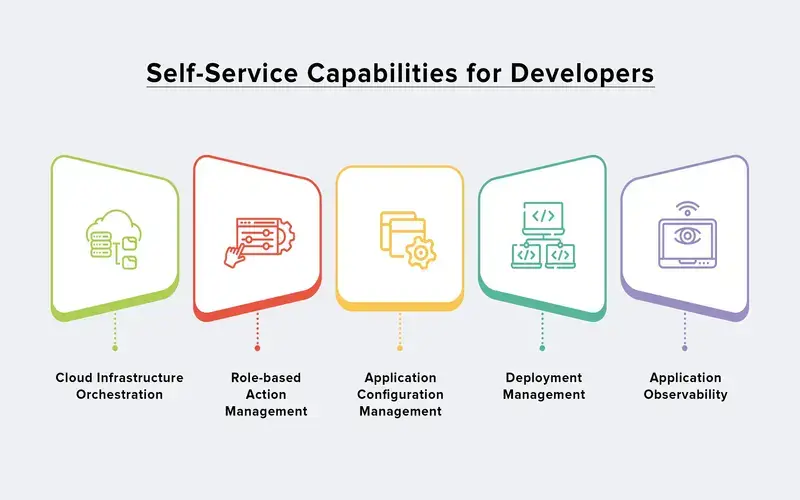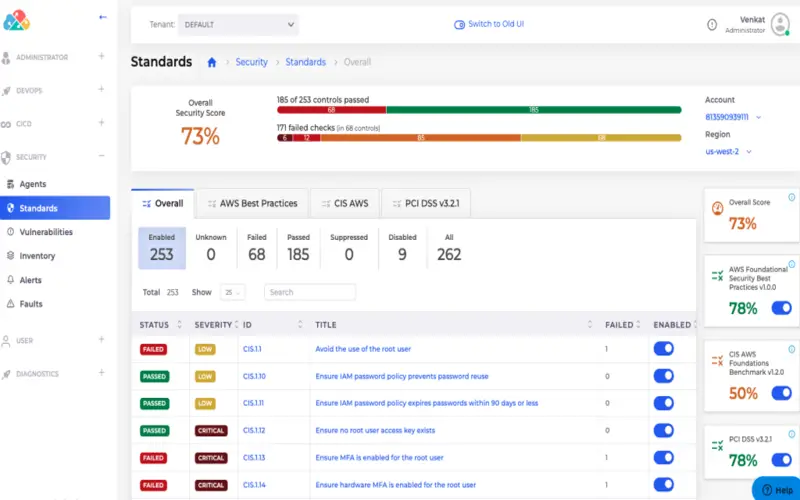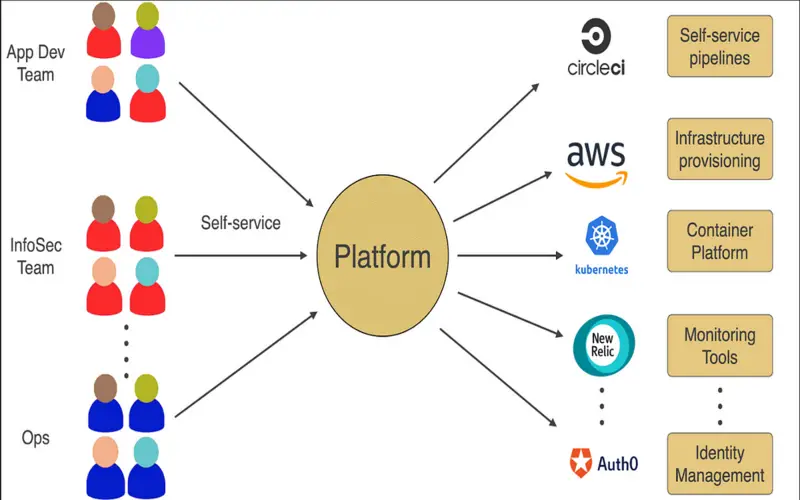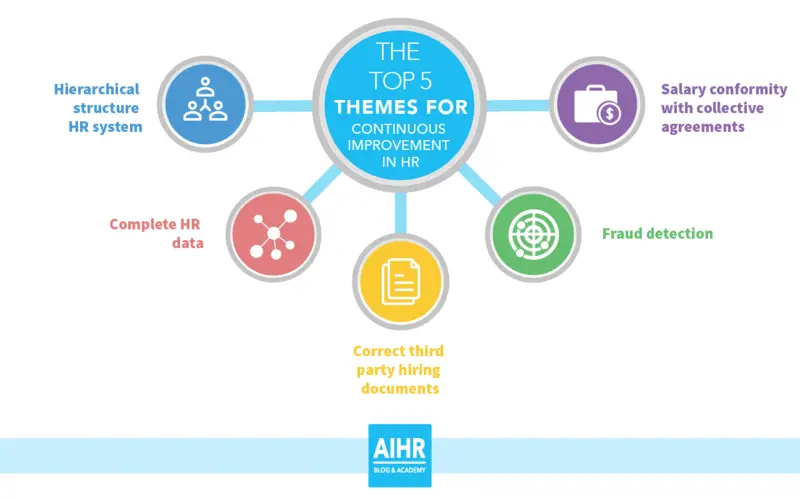What And Why Is Developer Self-Service?
Earlier falling into difficulties, let’s look at what developer self-service term as and the facilities it carries to both developers and companies.
Developer self-service is a clone in which software developers can create the services and environments they need to be flexible without having to ask or rely on the IT staff to put up the solutions.
In general, programmers achieve this through a business self-service field that transforms a variety of ready-made, formally supported solutions, such as a service that allows developers to swiftly fire up a Kubernetes batch or construct a CI/CD pipeline using authorized tools.
What Is Platform Engineering?
Platform Engineering is rapidly emerging as a potent antidote to the complexity produced by cloud-native environments.
The Platform that Doesn’t Align with Developer Challenges
Generally, the most common difficulty of making an excellent self-service programmer solution is the risk the solution won’t address the programmer’s pain focus. It can happen because the people who designed and manufactured the self-service platform are not always programmers or members of the business development teams as a whole. As a result, they don’t know what programmers necessary to be flexible.
Platform Engineering Examples
There is an excess of platform engineering examples that cut across empires.
Cloud Computing Platforms
A cloud service offers companies clone including manufacturing and organizing the structure on which companies host their applications and details. In inclusion, they provide scalable and flexible computing.
PaaS (Platform-As-A-Service)
Heroku is among the greatest platform engineering instances. The service allows programmers to manufacture, start, and perform applications wholly in the cloud. By providing robust employment climates, Heroku releases programmers from operational duties, enabling them to focus on technologies.
Container Orchestration Platforms
Container orchestration platforms are pre-owed for automating employment, scaling, and organization of applications. For example, Kubernetes, Docker, OpenShift, etc, are top-rated systems patterned by platform engineers.
Content Management System (CMS)
A CMS platform is a better example of this domain, with engineers providing a basis for strong websites and content delivery. For instance, WordPress, Drupal, and Joomla are all famous CMS systems.
1. Self-Service Capabilities
Platform engineering aims to provide programmers with self-service capabilities. It means manufacturing intrinsic interfaces and tooling that empower programmers to provide resources, employ applications, and organize their structure. By decreasing the reliance on primer processes and gatekeepers, self-service abilities allow programmers to repeat rapidly and maximize their flexibility.

2. Integration Of Devices And Innovations
Platform engineers must combine multiple tools and innovations to generate a cohesive and effective development climate. It involves combining source control systems, consistent combination/consistent deployment (CC/CD) pipelines, container correlation platforms like Kubernetes, and Infrastructure as Code (IaC) devices such as Terraform. By providing a single platform that incorporates these advancements, platform engineering teams enable programmers to focus on developing code rather than organising structure.

3. Programmers Experience And Flexibility
Platform engineering teams combine programmer experience and effort to provide a productive and enjoyable environment for software engineers. It involves offering clear documentation, training, and support and consistently enhancing the developer platform based on consumer feedback. By centring on the necessity of programmers, platform engineers can improve flexibility and encourage a culture of technology within the enterprises.

4. Enhancing Developers Experience (DX)
In today’s complex cloud-native landscape, programmers frequently struggle to select and implement the appropriate technologies for their workflows. However, with IDP, this obstacle becomes outdated. By offering a more accessible and standardized set of tools and services, IDP essentially enhances the programmer’s experience and now focuses on their core development work without being trapped by the complexity of device selection, resulting in improved flexibility and satisfaction.

5. Empowering Flexibility
Time is of the substance in software development, and detain can close up progress. IDP empowers programmers by providing self-service abilities surrounding everything needed for effective code testing and employment. It reduces the requirement to depend on distinct teams for multiple stages of development, allowing programmers to take charge of their work in a flexible flow. With IDP as their trusted associate, programmers can focus on what they do best: crafting exceptional code.

6. Service Maturity, Quality, And Security
Transforming high-quality software today is not an easy duty. A programmer must handle many elements, from tests to security, misconfigurations, assent elements, operational elements, and many more. These “maturity aspects” depends on hundreds of distinct tools and innovations. Some short examples include using Snyk to scan OSS packages, Python Linter to authorise code syntax, reversion tests, secret evaluation within the code, Jira ticket number as part of the PR title, and end-to-end.

7. Resolve Events Faster
Platform engineering groups offer continuous visibility over services and their holders. Its effective digitalization enables SREs, operations, and thing groups to see each service’s digital footprint. Merging the related groups and identifications quicker minimizes event resolution times and with the right combinations enables engineering groups to take end-to-end ownership.

8. Empower Developers To Self-Service
Manufacture the platform to enable programmers to add, organize, and adjust it. Every project team may have a barely distinct stack and cover path to construction. Alternatively, force them to start with the PE team and allow them to do it themselves. Set specific points in the development life cycle where they can choose or add tools, steps, or other pathways.

9. Minimizing Cognitive Load
Platform groups automate structure organization and allow programmers to self-serve flexible tools and workflows from A primely organized innovation platform. It minimizes the cognitive load on development teams.

10. Continuously Enhancement process
Platform engineers daily analyze the efficiency of the internal developer platform, collect feedback from consumers, and repeat on the field to address pain points and incorporate innovations.


















